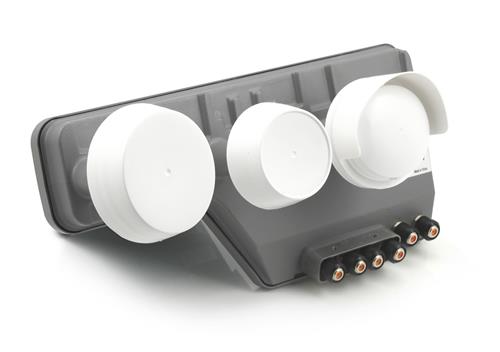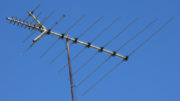If you’re looking to outfit a new commercial location with DIRECTV, you’re probably using a dish with the new Reverse Band 5 Legacy LNB. This dish will give you the ultimate flexibility to add hundreds of receivers if you need them. Unlike the consumer version of this dish, there’s no built-in SWM. Instead you get six outputs, which feed into the six inputs on the SWM-30. You’re probably familiar with using an AIM meter to align the current dish, so I won’t go into the details of actually aligning. However, getting lines 5 and 6 dialed in can take a little more work.
Do you really need an AIM meter?
Yes, you do. If you’re still holding onto a Birdog, Super Buddy, or other old DIRECTV meter, this is the time to upgrade. The AIM is the only meter that will work with this LNB, and you’ll need the latest version of it. You may be able to get raw signal from another meter but you’ll need the AIM to do it right.
And you should be using an amplifier and polarity locker.
I can’t say this strongly enough. Every commercial installation should have an amplifier and polarity locker. The STA series amplifier is the right one to use here. If the cable run is really short, you can avoid the amplifier but let’s be honest. This almost never happens in commercial installations.
The DTV6 series polarity locker should be installed as close to the dish as possible. This will provide power to the dish, which you will see is very important in this procedure.
Make sure your meter is properly set up.
In order to tune those lines in, you’ll need to make sure the AIM can see them. Press SETUP and make sure your setup looks something like the image below. Obviously the ZIP and account number should be yours, not the ones in this picture.

Depending on how complete your install is, you may be able to go to DETECT SWM and have some information filled in automatically. If you’re starting cold, you can set it all up manually.
Transponder Tune
Going into TEST and then Transponder Tune, you can then set up the system in the AIM the way that it’s actually installed, and select the right line to tune.

You can choose port 5 (closest to the main 4) or port 6 (furthest from the main 4) and tune these just like you would any other port. From here it’s just a matter of dithering the dish in to get the numbers you want.
But wait you’ll need to know this.
Port 6 is sort of special. Unlike every other satellite port on every other dish, it doesn’t accept power. This means when you tune port 6 you will need a source of power on port 5. Usually the easiest thing to do is to connect port 5 to the polarity locker which will power it. Then, you can tune port 6.
AT&T techs are given a little diplexer which sends power to port 5 and pulls signal from port 6. This is a hard part for non-AT&T techs to get hold of and besides it’s just one more thing to lose. Since you’re going to be putting in that polarity locker anyway (right?) you don’t need it. Just power on the polarity locker and you should be all set.
If you are really dead set against using a polarity locker, you can temporarily connect port 5 to an old PI21 power inserter (the black one, not the newer gray one.) That’s more voltage than it’s accustomed to but not much, and for short periods of time it will be ok,





